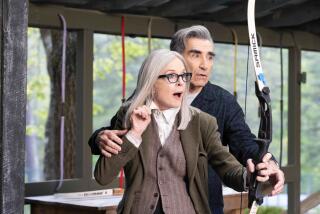Sandblasting the Great Stone Face : After years of neglect, pristine versions of Buster Keaton’s comic masterpieces are released to mark the centenary of his birth.
- Share via
What could be more welcome for movie lovers than the reissue on cassette and laser disc of the finest silent work of Buster Keaton? Unlike plenty of the other great silent film artists, many of Keaton’s films have been maddeningly unavailable. One of the great legacies of American film has languished in vaults, or in sub-par video dupes.
But now, virtually all of Keaton’s silent features and shorts will be available in video stores or by mail starting Wednesday in beautifully restored versions digitally remastered from original negatives. 1995 is the centennial of Keaton’s birth and the timing couldn’t be better.
The first boxed set includes all of the shorts and features through “Sherlock Jr.” (1924)--three boxes and eight titles in all. The second set, including “The Navigator” and “Seven Chances,” will go on sale April 5 and the third, including “The General” and “Steamboat Bill Jr.,” on June 1. Although, with the exception of “Sherlock Jr.,” Keaton’s greatest glories are to be found in those second and third boxed sets, there’s plenty of wonderful stuff in the first set too. Keaton, unlike Chaplin, didn’t have to work through a lot of films until he nailed his comic persona; it’s there just about from the beginning, with the shorts “One Week” and “The High Sign”--both 1920.
Keaton’s famous deadpan was, of course, tremendously alive. It’s probably the most expressive blankness in the history of movies. In “One Week,” Buster builds a prefab house for his new bride but the boxes containing the materials have been arranged out of order. The resulting house is a marvelously askew contraption--a sagging wonder. And it revolves, too. A fierce windstorm sets up one of Keaton’s great set-pieces, with the house spinning like a top on its axis while the undaunted husband continually flings himself into a doorway, a window, in order to rescue his wife--and then gets continually spun out again.
Keaton was the most physical of the great comics, and his hair-raising stunts in his movies are made even more funny-scary because of their realism. Keaton almost always did his own stunts, and his bouts with runaway trains (a favorite of his) and collapsing homes are flabbergasting because what you see is what you get. You don’t know whether to laugh or hold your breath.
Even though Keaton was one of the first great film artists to recognize the magical trickery of the medium--in “Sherlock Jr.” he plays a projectionist who enters into the action on the movie screen--he loathed trickery in his own stunts. As the years went on he perfected his routines, and these early films show us warm-ups for some of the great Keaton moments to come. In “One Week,” for example, Keaton throws in a moment when the front of the house falls on top of him with the open top-story window protecting him from the crunch. In “Steamboat Bill Jr.” (boxed set 3) the bit is so perfectly done that it’s transcendent.
What these early films lack in transcendence they make up for in flat-out funniness. “The Three Ages” (1923) was the first of Keaton’s independent feature-length comedies, and it’s one of the most hilarious movie parodies ever made. It chronicles Buster’s lovelorn pursuits in three different eras: the Stone Age, Roman, and Modern. In each era his rival is played by a young-looking Wallace Beery, and Keaton works in parodies of “Ben-Hur” and D.W. Griffith’s “Intolerance.” He throws in chariot races, train chases, and keeps it hopping for all of its 63 minutes.
One of Keaton’s funniest shorts is “My Wife’s Relations” (1922), in which Buster mistakenly marries into a family of very large and very stupid people. There’s a great scene where Buster, at the dinner table, can’t consume a mouthful because he’s constantly passing salt, pepper, platters, bread back and forth between his behemoths.
“The Saphead” (1920), which made Keaton a star, is also featured in this first boxed set, and it’s easy to see why. He plays a dim, spoiled scion who ends up buying a seat on Wall Street--he thinks he’s actually buying a seat.
“Our Hospitality” (1923) was Keaton’s first major film, in which he finds himself in the middle of a family feud down south. His rescue of the heroine from a raging waterfall is the kind of daredevil sequence that Keaton could do better than anybody else. He swings down by a rope to pluck his inamorata from the crest of the falls and the split-second precision is so heroic it’s hilarious.
And then there’s “Sherlock Jr.,” one of the glories of silent film comedy, which, in addition to the movie-within-a-movie jaunt, features Buster on a runaway motorcycle in a chase scene so surrealistically lickety-split it defies categorization.
The Keaton series is especially welcome because children will love them. I can’t think of a better gift for a child who loves movies than these boxed sets of Keaton wonders. For that matter, I can’t think of a better gift for an adult film lover either.
* The films are being issued on tape by Kino on Video, 333 W. 39th St., Suite 503, New York 10018. To order direct: (212)-629-6880. Outside New York: (800) 562-3330. Boxed set No. 1 goes for $79.95. Laser disc is being issued through Image Entertainment.
More to Read
Only good movies
Get the Indie Focus newsletter, Mark Olsen's weekly guide to the world of cinema.
You may occasionally receive promotional content from the Los Angeles Times.










